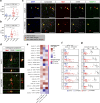Intracellular accumulation of amyloid-ß is a marker of selective neuronal vulnerability in Alzheimer's disease
- PMID: 40467545
- PMCID: PMC12137956
- DOI: 10.1038/s41467-025-60328-w
Intracellular accumulation of amyloid-ß is a marker of selective neuronal vulnerability in Alzheimer's disease
Abstract
Defining how amyloid-β and pTau together lead to neurodegeneration is fundamental to understanding Alzheimer's disease (AD). We used imaging mass cytometry to identify neocortical neuronal subtypes lost with AD in post-mortem brain middle temporal gyri from non-diseased and AD donors. Here we showed that L5,6 RORB+FOXP2+ and L3,5,6 GAD1+FOXP2+ neurons, which accumulate amyloid-β intracellularly from early Braak stages, are selectively vulnerable to degeneration in AD, while L3 RORB+GPC5+ neurons, which accumulate pTau but not amyloid-β, are not lost even at late Braak stages. We discovered spatial associations between activated microglia and these vulnerable neurons and found that vulnerable RORB+FOXP2+ neuronal transcriptomes are enriched selectively for pathways involved in inflammation and glycosylation and, with progression to AD, also protein degradation. Our results suggest that the accumulation of intraneuronal amyloid-β, which is associated with glial inflammatory pathology, may contribute to the initiation of degeneration of these vulnerable neurons.
© 2025. The Author(s).
Conflict of interest statement
Competing interests: This study was partly funded by Biogen. PMM has received consultancy fees from Sudo Biosciences, Ipsen Biopharm Ltd., Rejuveron Therapeutics, Nimbus Therapeutics and Biogen. He has received honoraria or speakers’ fees from Novartis and Biogen and has received research or educational funds from BMS, Biogen, Novartis, Invicro and Nimbus Therapeutics. The remaining authors declare no competing interests.
Figures






References
-
- Morrison, J. H. et al. A monoclonal antibody to non-phosphorylated neurofilament protein marks the vulnerable cortical neurons in Alzheimer’s disease. Brain Res.416, 331–336 (1987). - PubMed
-
- Saiz-Sanchez, D., De la Rosa-Prieto, C., Ubeda-Banon, I. & Martinez-Marcos, A. Interneurons, tau and amyloid-β in the piriform cortex in Alzheimer’s disease. Brain Struct. Funct.220, 2011–2025 (2015). - PubMed
MeSH terms
Substances
LinkOut - more resources
Full Text Sources
Medical

